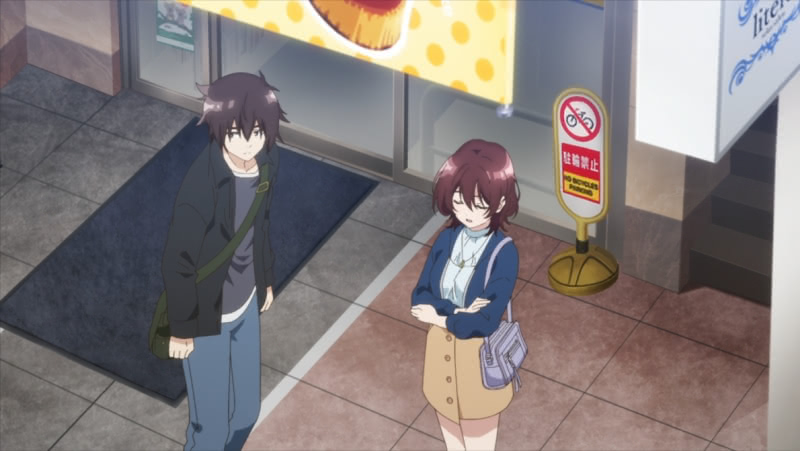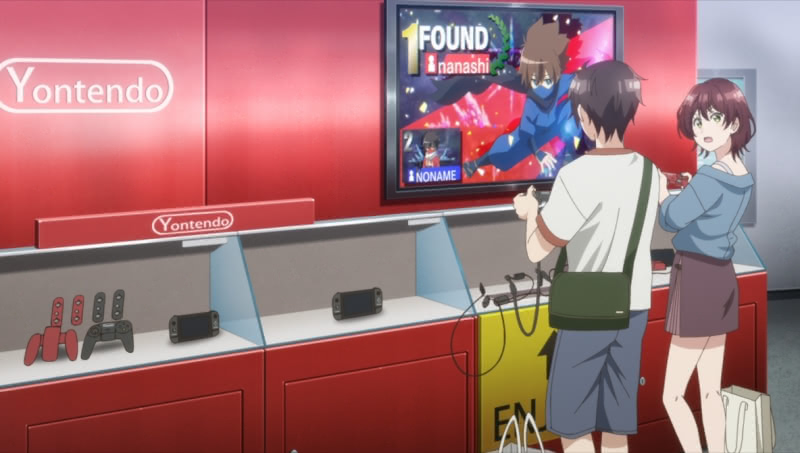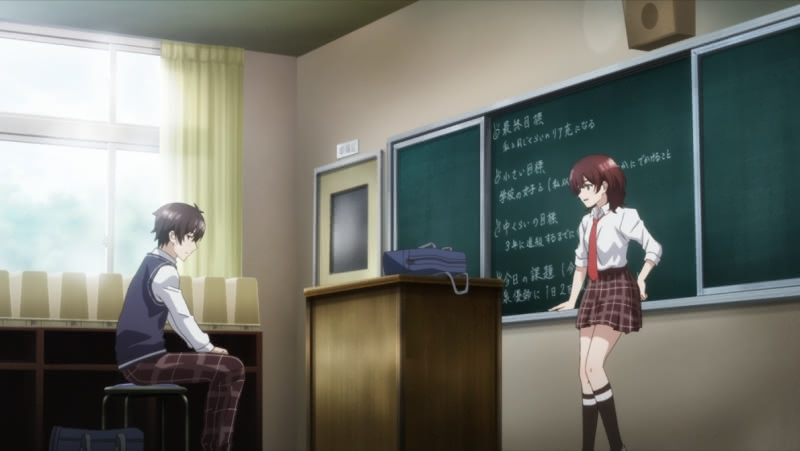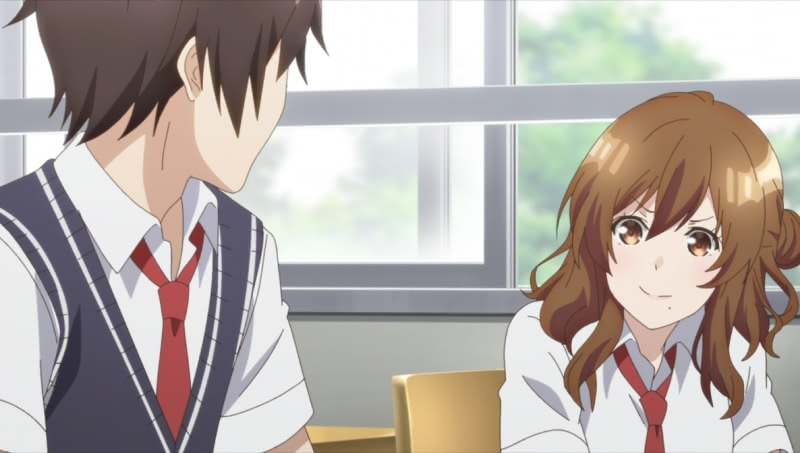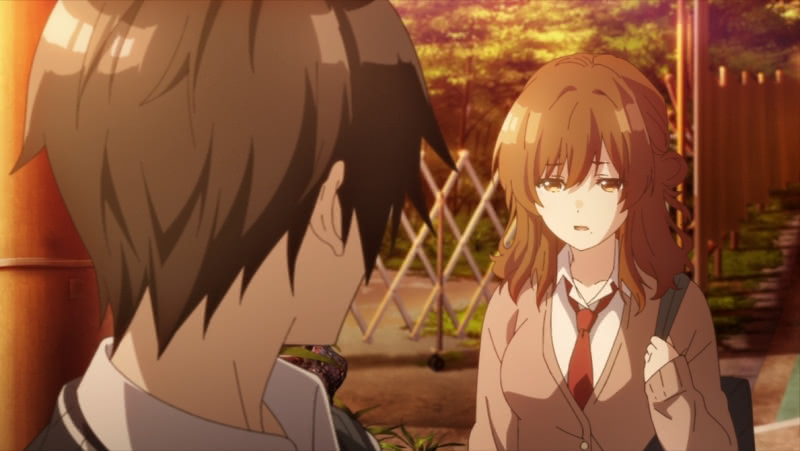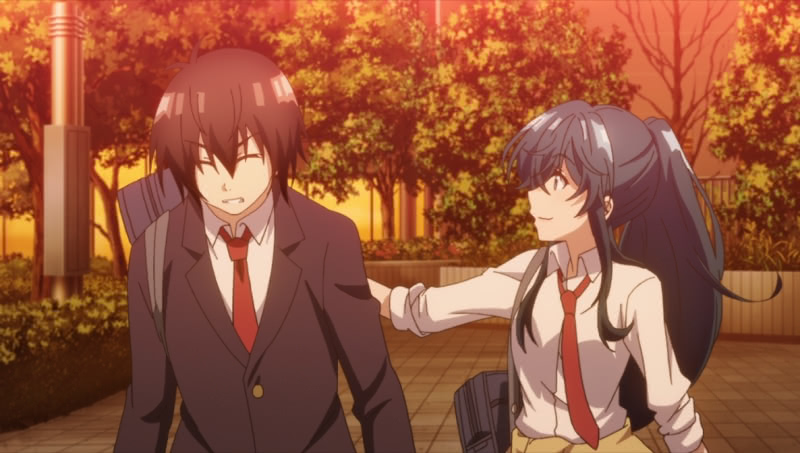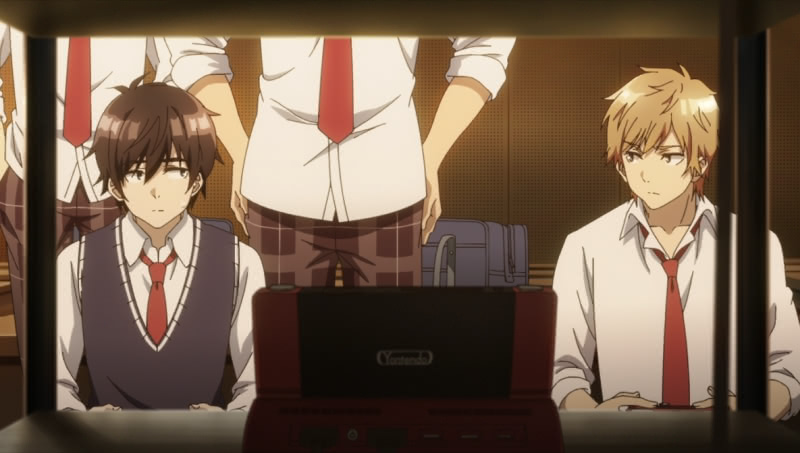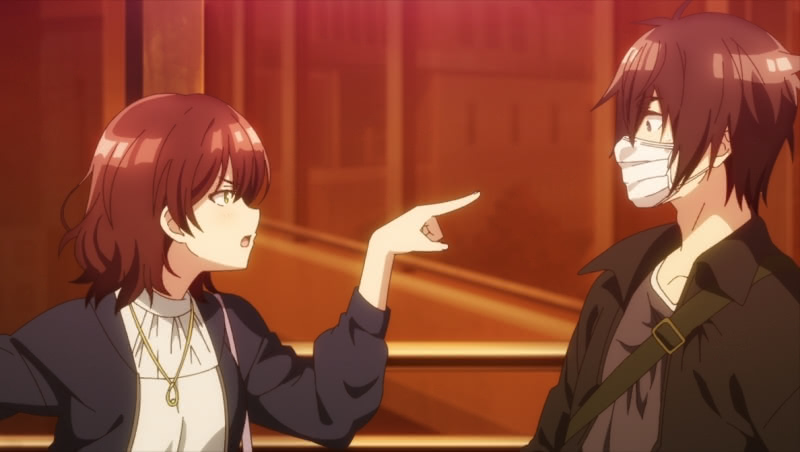Bottom-tier Character Tomozaki (Jaku-kyara Tomozaki-kun) is a Japanese light novel that spawned a 12-episode anime adaptation in 2021. Its second season will begin in January 2024. I watched the first season and, as I explained in an honorable mention note in my 2021 anime year-in-review article, came away with a qualified positive impression of the season. Having watched the first season and with the second season approaching, I decided to write a review of the first season – both to offer my opinion of the series and to either help people who have not seen the season decide whether they want to give the series a try or to refresh the memories of those who will be watching the second season. Because this review is designed to be helpful to people who may be considering watching the series, I will only discuss the plot in general terms.
Update (April 5, 2024): I reviewed the second season as well.
General Plot Overview
(Note on names: Different characters in the series refer to other characters by their first name, last name, or nickname depending on their relationships. Because the entire series is seen from Tomozaki’s perspective, I will use the names he most often uses for other characters in my review.)
Bottom-tier Character Tomozaki is set in a high school and features second-year (equivalent of U.S. 11th grade) students.
The sole view-point character of Tomozaki is Fumiya Tomozaki, a disheveled boy with no social life whatsoever. However, he has one stand-out point, albeit one that is unknown to those around him. Tomozaki is the best Attack Families player in Japan as evinced by his first-place ranking on the national online ladder. What is Attack Families? It will only take anime viewers about 10 seconds to see that it is definitely not Super Smash Brothers re-named for copyright reasons. Because mercurial Japanese light novel and anime boys have peculiar ways of framing their lives, we see that Tomozaki views life as a trash game and Attack Families as a godly game.
Tomozaki’s life changes early in the first episode when, after beating the nationally second ranked Attack Families player for the umpteenth time, he is invited to meet this opponent in person. Although Tomozaki, playing as “nanashi,” always beats the second ranked player, known as “NO NAME,” he is always impressed with how much the second-ranked player improves and changes his strategy. He accepted the offer to meet NO NAME in real life.
Upon meeting NO NAME, Tomozaki realizes that he had erred in one key assumption. He had assumed NO NAME was a guy (for whatever it is worth, that was not an unfair assumption given what I would guess are the demographics of real-life elite competitive Super Smash Brothers players). He is surprised to find that NO NAME is his classmate, Aoi Hinami – who is very much not a guy. Moreover, Hinami is not only not a guy, she is also the most popular and respected girl in Tomozaki’s school. While Tomozaki is surprised to see that Hinami is NO NAME, Hinami is highly disappointed when she sees Tomozaki, a classmate she had no meaningful with. While admitting that she is not being kind, she rips into Tomozaki for going out to meet someone while dressed terribly (she’s not wrong) and criticizes him for going about his life as if he has quit the world (granting she has no standing to say this, she is not wrong on the merits). Hinami is specifically disappointed because she had come to respect “nanashi,” and she cannot believe that this gamer she respected carries himself so poorly (I am not sure she should have been so surprised). In turn, Tomozaki has an outburst, ranting about how real life is a terrible game and that Hinami should not criticize him because she is smart, attractive, and charismatic, while he is none of those things. Tomozaki’s assertion that Hinami had it easy triggered something in her – so she whisks him off to her home.
There, Hinami reveals to Tomozaki that she puts a great deal of effort into her public persona – going as far to show him how different she looks without makeup (note: she does not look meaningfully different in the anime without makeup – the studio did not quite have the animation chops for the scene in question). Hinami gives Tomozaki an inspiring speech – gamer to gamer.
While Tomozaki is unconvinced that life is a good game, he finds himself moved by Hinami and accepts her offer to teach him how to be good at life. So begins their odd teacher-mentor relationship wherein Hinami coaches Tomozaki on how to become a social creature and Tomozaki continues to defeat Hinami repeatedly in their online Attack Families matches.
Note that everything above described the first episode – which does a good job of setting the stage for what is to come. Before continuing, however, I would encourage viewers to think carefully about the scene wherein Hinami convinces Tomozaki to accept her tutelage because it establishes several important points about her character in a more explicit way than at any point later in the series.
Tomozaki and Hinami begin meeting at school before classes every day. In each of their meetings, Hinami gives Tomozaki “assignments” – for example his first assignment is to talk to his next-desk neighbor – and Tomozaki reports back to Hinami on his progress. Hinami sets a long-term goal for Tomozaki to get a girlfriend – which is curious in light of the fact that Hinami herself is unattached (note: not curious in the sense that Hinami is secretly going for Tomozaki but curious because she gives Tomozaki a goal that she very clearly does not pursue in her own life). While Hinami’s coaching of Tomozaki is done in secret – one interesting (and good) point of the set up is that the growing friendship between Hinami and Tomozaki is not secret. In fact, Hinami specifies for some of Tomozaki’s assignments that he start conversations when she is present so she can intervene if he gets himself into a bind. She also tends to encourage Tomozaki to become friends with her friends and takes the initiative in integrating him into her friend groups when she sees that he is making every effort to fulfill her assignments. Characters note over the course of the series that Tomozaki and Hinami appear to be friendly – but no one is quite certain how or why (note: there is no insinuation from anyone that their relationship is romantic, likely in part because that possibility would seem to be unfathomable to those around them).
Hinami’s initial assignments are simple – I noted she made Tomozaki talk to his neighbor. She follows up with having him do things like make a joke or get someone around him to note his improved mood. She works on improving his posture and takes him shopping for new clothes and a hair cut. Tomozaki does not always understand her assignments, but the gamer in him makes him take everything she gives him seriously, and he gradually becomes more confident and able to carry out conversations – especially after listening to recordings of himself talking to Hinami and memorizing stock conversation topics for different occasions.
Towards the middle of the season, Tomozaki begins to split into arcs centered on a girl. First is Yuzu Izumi, Tomozaki’s next-desk neighbor who, despite having nothing in common with Tomozaki, has a request that he is uniquely suited (perhaps more uniquely suited than anyone in Japan) to help her with. Next we have Minami (“Mimimi”) Nanami, the eternal second to Hinami who decides to challenge her friend and rival in the school election for student council president – an arc that continues into the aftermath of the election. Throughout these arcs, we also have Tomozaki developing a relationship with a quiet, bookish classmate named Fūka Kikuchi, who Hinami designates as Tomozaki’s love interest because of some vague signs that Kikuchi is curious about him. Lest one think “why is Tomozaki only becoming friends with girls,” this also occurs to Hinami. After having initial success helping him become friendly with some of the girls in his class, she decides it is important for him to make guy friends as well – and she focuses at different points on Takahiro Mizusawa (perhaps the closest thing to a male Hinami in reputation) and the surly Shūji Nakamura, who bears an early grudge against Tomozaki after having challenged him to Attack Family without having any idea what he was getting into.
There are two constants in the arcs. First is Hinami’s relationship with Tomozaki. Second is Tomozaki’s Hinami-driven relationship with Kikuchi.
By the second half of the series, Tomozaki is a well-dressed (by the standards of young trendy Japanese kids, I personally think he should wear collared shirts) young man who no longer breaks out into a cold sweat at the thought of a conversation. He has friends, and people around him see him as one of them – albeit a bit a bit of an unusual one in his earnestness. He is also a firm part of Hinami’s friend groups. But as Tomozaki improves at the game of life, he begins to think about his own objectives.
While Hinami and Tomozaki get along very well and an astute viewer can see that Hinami appreciates having a friend whom she does not feel pressured to put on an act with, there are signs beginning early in the series that their worldviews are not entirely in accord. I would frame the disagreement which pops up at times early and blows up toward the end of the season as being a disagreement over ends. Tomozaki wants to learn how to become good at the game of life, but why does he want this? What is it that he wants from life? Is his answer the same as Hinami’s? Doubts grow as his personal situation improves. Unsurprisingly – and without getting into unnecessary details – Hinami’s road map for how Tomozaki should handle his interactions with Kikuchi. the love interest she designates for him,, proves to be the main source uncertainty for Tomozaki throughout the season.
Series Details
| English Title | Bottom-tier Character Tomozaki |
| Japanese Title | Jaku-kyara Tomozaki-kun |
| Aired | January 8, 2021 through March 26, 2021 |
| Studio | Project No.9 |
| Director | Shinsuke Yanagi |
| Based On | Light Novels by Yūki Yaku |
| Links | Wikipedia; ANN; MAL; AniDB |
My Review (Spoiler-Free)
Tomozaki’s first season has two principal strengths.
Firstly, I appreciate how Tomozaki’s social abilities and social standing improves gradually. While Hinami’s orders seem a bit arbitrary – that Tomozaki does gradually improves his ability to talk to people makes sense in how it is handled. Moreover, I think the series made the correct decision to have Hinami make an effort on her end to help Tomozaki outside of giving him assignments. Tomozaki’s transformation requires his buy-in and effort, but it is greatly helped along by Hinami’s willingness to be friendly with him and make him a part of her friend groups. This helped mitigate the danger that Tomozaki’s occasional social good fortune could come off as too convenient. To be sure, Tomozaki is not adverse to certain conveniences, but seeing Hinami, one of the school’s dominant social figures, pulling strings helps make Tomozaki’s steady progress with others seem more plausible. I will add that there were times when Tomozaki stumbles into a positive situation that Hinami did not foresee – which served to show his personal growth and increasing autonomy.
Secondly, the series had what I think was the correct view of Tomozaki’s initial situation. Tomozaki does not flinch in showing us that Tomozaki’s perspective at the beginning of the series was warped – and it is to Hinami’s credit, notwithstanding her faults (which we will address) – that she found a way to make the case for change in a way that would be amenable to her video gaming rival. The message is not that gamers are great or gamers or trash, but that Tomozaki could apply some of the work ethic he used to become an amazing video gamer to improving his situation in the real world.
The second point would have not been interesting had Tomozaki simply been content with becoming relatively popular. However, we see that he is smart and inquisitive (note: one interesting oversight is that there is no reference in the series to Tomozaki’s academic standing, which struck me as unusual) – not merely a hard worker. He tries to understand why Hinami wants him to do things, and while he is generally deferential on account of his respect for her and what she does for him, he admirably questions some of her goals on account of the fact that they seem to focus on superficiality rather than substance. Moreover, the series is smart in implicitly showing that Tomoaki has to develop the social skills and earn the social status to even be in a position to be concerned with what it is he actually wants – since the Tomozaki we meet in episode one had few choices given the box he put himself in.
In a final note on Tomozaki the character – I appreciate that save for a few games are awesome meltdowns (to be fair, it is on brand), the series opted to play Tomozaki mellow. He stammers and stutters like someone who is shy and does not know what to say. The idea of dating is foreign to him, but he does not turn red as a beet and flail around in an exaggerated manner whenever a girl talks to him. For a series that is very adjective anime and surrounds Tomozaki with characters who often have a tendency to play out their archetypes, Tomozaki himself is surprisingly down to Earth.
The elephant in the room in Tomozaki’s first season is Hinami, but let us set that aside for the moment to discuss the comparative characters. While I have a broadly favorable view of Tomozaki himself, the side characters are largely one-dimensional – a defect that negatively distinguishes Tomozaki from higher quality works in the genre of “guy finds himself involved with problems of girl of the week.” Now before continuing – and in the spirit of charity – I will suggest that in certain cases, one reason some side characters may be one-dimensional is because many of Tomozaki’s paint-by-numbers interactions (especially in the early-going) are superficial – and we only see characters from his perspective. Assuming arguendo the source material (and for anime viewers, the second season) does something interesting with a new and improved Tomozaki, we may see him interact with side characters on a more personal level. But this is a review of season one – so we will review it as is.
Other than Hinami, there are four girls who get significant screen-time and three of the four have what could be described as an “arc.” Because Tomozaki is the sole view-point character, the significance of all side characters depends on their relationship to him.
The first girl who receives a proverbial arc is the most distant from Tomozaki – Yuzu Izumi. She is defined largely by her romantic interest in Shūji Nakamura. She is the first girl Hinami forces Tomozaki to talk to – and he struggles in light of the fact that they have nothing at all in common. However, a stroke of good fortune (entirely unplanned by Hinami) makes Tomozaki the best person in Japan to help Izumi with a particular issue. He earns her gratitude and some level of trust – and the event provides Tomozaki with his first opportunity to use his growing social powers to be of use to someone else. There are no signs that Izumi is harboring some deeper issue or crisis, past or present, like there is with the other girls. The series presents her as is, an ordinary girl with ordinary concerns going about her life. I found Izumi to be pleasant enough and I think her arc proper was the most consistent of the character arcs in Tomozaki.
The second arc girl and the one who Tomozaki ends up the most involved with is Minami “Mimimi” Nanami. I had some difficulty with Mimimi. She is a bundle of energy whose motto is to smile and be cheery when she is down, and she is something of the eternal second to her friend, Hinami, in their school. While she appears to be popular and well-regarded, she does not consider low social status in deciding who she talks to and associates with, which leads Hinami to identify her as an early potential friend for Tomozaki. The issue with Mimimi is that she often behaves like a cartoon character (granting she is, in fact, a cartoon character), namely being over-the-top physically affectionate in embarrassing ways toward her best friend, Hanabi “Tama” Natsubayashi. To be sure, Tama claims she only pretends to find Mimimi’s over-the-top affection annoying and is grateful to Mimimi for things that are beyond the scope of this review – I found Mimimi annoying when she is with Tama. Her arc is effectively two separate and related episodes, with the first being one of the better episodes of Tomozaki’s first season and the second feeling forced in its execution. I never fully warmed to Mimimi in season 1, but as I noted above – she is much less grating when Tama is not present (which, fortunately, is more often than not in the second half of the series). Tama’s backstory plays a small role in season 1 and is the subject of the second of two short post-season 1 original video animation episodes, but despite being friendly with Tomozaki, she does not play any independent role other than providing some context to the relationship between Hinami and Mimimi.
Finally, we have Fūka Kikuchi, Hinami’s arranged love interest for Tomozaki. Kikuchi fits the painfully shy bookish girl archetype – right down to her appearance. She is the only one who seems to have thought anything of Tomozaki before he improved his social bearing. It is no exaggeration to say that Tomozaki’s interactions with Kikuchi, to the extent they are encouraged by Hinami, are what cause him to consider what kind of game life is. Kikuchi is perfectly fine but she has what I will coin here as Sakamaki Syndrome. Maria Sakamaki is a six-year old girl in an excellent visual novel I reviewed, Collage. I criticized Sakamaki’s writing in that she sometimes speaks like an oracle, dispensing wisdom to help the adult characters see things in a specific way. Now Kikuchi is older than six and seems like a sharp enough girl – so it is not entirely the same here. But there are numerous instances where she makes some keen observation out of the blue about people we never actually see her interact with that changes Tomozaki’s way of thinking. Moreover, some wisdom she dispenses in the very late stages of the first season comes off as a bit stilted to me. She provides helpful, coherent insights to Tomozaki about Tomozaki, but her non-Tomozaki commentary is often too convenient. Another convenient aspect of Kikuchi is that because of her kind personality and her small, pre-existing interest in Tomozaki, Tomozaki has more leeway to make mistakes and learn from mistakes in his interactions with her than he might with some of the other characters.
(Aside: Noting that I know nothing about what happens beyond beyond season one, I have a feeling that Kikuchi is set up to be the girl who many fans of the series will want Tomozaki to end up with, only to lose out (assuming arguendo all love is a battle) to the inevitable. I would be surprised if it is not the majority prediction.)
Hinami also tries to make sure that Tomozaki engages in male bonding, perhaps cognizant of the fact that most of her friend group is female. Most of Tomozaki’s guy interactions are with Takahiro Mizusawa and Shūji Nakamura. Nakamura comes up first, but other than his miscalculations in challenging Tomozaki to battle in Attack Family, he does not see much screen time until the one of the later episodes. Mizusawa ends up receiving more screen-time and interactions with Tomozaki. While nothing about Mizusawa in season 1 is groundbreaking, he is the only character aside from Hinami and Mimimi who shows distinct signs of having more to his personality than he initially lets on – and I expect he will become an even more significant figure going forward.
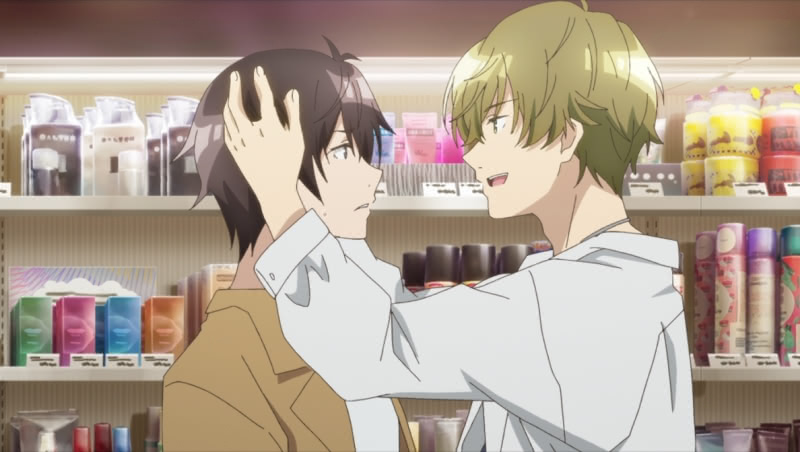
Now for Hinami.
Hinami is significant enough to be the co-main character of Tomozaki. It is her determination to take Tomozaki under her wing that sets the entire story in motion – and she is his closest confidant throughout the entire season. As the series progresses – we see Tomozaki begin to understand that while what he wants aligns with what Hinami is helping him achieve in many respects, what Hinami wants, for reasons he initially struggles to put together, is not the same as what he is ultimately looking for.
Having completed season one, and without spoiling particulars, I think the ultimate question of Tomozaki, beyond Tomozaki deciding what to do after achieving the ability to function socially, is as follows: Who is Aoi Hinami? She is confident, seemingly perfect in all respects save for losing to Tomozaki in a video game, and admired by everyone around her. It is obvious early that there is a difference between how she behaves around people, even her supposed close friends, and how she behaves without the audience (here being only Tomozaki). Hinami in season one is interesting – despite being more than a bit robotic – precisely because she reveals little about herself. She clearly, arguably inadvertently, becomes Tomozaki’s best friend – but we do not get to know her well because he does not know her well. Why does she spend hours playing a video game in secret? Why did she want to meet her video game rival? Why does she admit to Tomozaki that she is not perfect? Why does she decide to become Tomozaki’s life coach? Why is she so insistent on Tomozaki finding a girlfriend? Why does she invest so much time into Tomozaki? Why is she so motivated to live up to the expectations people have for her? Who was she before she became the Hinami we meet in episode 1. Given the season one information, there are different plausible answers to these questions – and more – that we cannot rule out. Moreover, it is entirely possible that the answers to some of these questions are not the same in episode 12 as they were in episode 1.
While I am cautiously optimistic about the second season, I have concerns based on the first about whether the author, from the story’s earliest stages, had a clear and distinct idea of what he was doing with Hinami. It is one thing for Tomozaki and the reader/viewer to not have answers about Hinami yet, but the author must have the answers for the evolution of the character to make sense, and Hinami’s early development should lead us to finding the answers to all the questions raised It is no exaggeration to say the entire series will depend on the answers – but we will have to watch season two to see how successful Tomozaki is in developing Hinami’s character.
Returning to broader matters, Tomozaki is an inconsistent series in terms of episode-to-episode quality. The opening episode is one of the best of the entire series, and episodes 3-6 were generally solid with 3 and 5 being highlights. The episode 7-8 arc is mixed with episode 7 being solid but 8 being shaky. Episodes 9 and 10 are like a breather until a few significant scenes. Episodes 11 and 12 mark what is effectively the final arc. 12 features one of the best scenes of the series and ends in a strong way that made me hope for a second season back when it originally aired. I will note, however, that episode 12 actually ends with an odd montage showing some future events and, in hindsight, it comes off as if it were hedging a bit against the possibility that there would be no second season. I will note there are two short original video animation episodes on Crunchyroll – neither is important, but “episode 13” is amusing while I “episode 14” is a bit dull (my character analysis suggests why). One interesting note on the OVAs is that neither is told from Tomozaki’s perspective and Tomozaki effectively only makes a cameo appearance in one of the two.
Anime involves an audio-visual component, but the animation in many series is not the point. Tomozaki’s animation quality could charitably be described as mediocre. You can tell that the team marshaled resources for certain scenes and some episodes (e.g., 9) looked demonstrably better than others (e.g., 10). The series covers for this general lack of quality animation by cutting to faces and feet and panning to wide shots.
Speaking of feet, I could not help but notice on my second watch (I do not recall having noticed it back in 2021) that the camera has a tendency to linger on Hinami’s and Mimimi’s legs, but not on the legs the other girls. Lest one things we are following Tomozaki’s gaze, the lingering occurs in several scenes where Tomozaki is standing right next to Hinami or Mimimi, leaving us to infer that we should interpret their foot movements or something to that effect. I thought it was peculiar that this is really localized to Hinami and Mimimi – for example, one could make the case that Yuzu Izumi has a prettier character design than either Hinami or Mimimi, but I did not pick up on the leg focus there. Moreover, other than noting on one occasion that Kikuchi is cute (the context suggested he meant adorable) and reacting to Hinami messing with him on a couple of occasions, Tomozaki’s monologues are not occupied with thoughts about the appearances of the girls, much less their legs – so it does not seem to be his fault (contrast with my recently reviewed The Dangers in My Heart, where we tend to see things from the protagonist’s perspective). Finally – it is certainly not a fan-service show. The school uniforms are more realistic than many series of the type and the trendy cast tend to dress like trendy, stylish young people outside of school. Everyone is normally proportioned. Is the leg thing in the novels? Peculiar.
But legs aside – character designs are clearly a focus of Tomozaki. Tomozaki’s physical transformation is handled well – the animators paid attention to posture and shows how subtle things like fixing his hair and changing his outfit could have a dramatic effect on his appearance, which of course is Hinami’s correct idea (see a similar phenomenon discussed in my review of the first season of The Angel Next Door Spoils Me Rotten). The improved Tomozaki is a decent looking guy – he does not look like he would be thought of as being as conventionally attractive as his two guy friends, but handsome enough for all normal purposes when he cleans up. Both of the two main male friends (as well as a third guy who exists more for comic relief) are designed well, although it took until the middle of the series for the two other than Shūji Nakamura to register on me on account of the fact it was not clear they would have any meaningful continuing role. Of the girls, Izumi has the best design in that they managed to make a naturally pretty girl without over-reliance on visual cues to tell us what her personality is. Hinami’s design necessarily required and received the most care because, in light of the fact she is calculated in what she says, her sometimes involuntary facial reactions provide one of the few ways to see that she is thinking something different than what she is saying. Kikuchi and Tama are fine but I found them to be designed to adhere too closely to archetypes, which gives them the effect of looking a bit alien when compared to the guys, Izumi, and Hinami. Mimimi’s bright blue hair made me think of my anime hair color series, but her design conveys that she is athletic and her mannerisms convey that she is energetic.
Neither the opening nor the ending song is remarkable, but the ending has a fun little animation and decent enough track to earn a slightly above average evaluation.
Review Conclusion
One reason I singled out Tomozaki for a brief discussion in my 2021 anime review was because I appreciated the fact that the series was better than what its premise alone would have suggested, and I had some hope then that we would see a second season. Given its premise, it could have gone in many directions. But, even granting its myriad imperfections, the first season of Tomozaki has a good message – especially for its primary target audience. First, it comes down strongly and correctly in support of the view that Tomozaki was not living his life well, and that while there is nothing wrong with dedicating himself to a game, that is not a reason to shun the outside world. Second, instead of trashing video games and gamers, it comes up with some creative ways to show how Tomozaki can apply some of the same principles that he used to become a world-class gamer to real life, starting with the fact that the game was what facilitated his relationship with Hinami. Finally, the series takes its time in building up to Tomozaki’s rejection of social climbing for social climbing’s sake as an end goal. But it is precisely because Hinami gives Tomozaki the gift of self-confidence and dignity that he is able to take another step, accepting her means but questioning her ends. One could say that Hinami gave Tomozaki the tools he needed to disagree with her.
I have seen comments and reviews comparing Tomozaki to My Youth Romantic Comedy is Wrong, As I Expected, or “Oregairu” for short. I understand the reason for the comparison in that both series feature initially disaffected and anti-social high school students who, for different reasons, are made to engage with the world around them. With that being said, separate and apart from the thematic differences, this comparison does not do Tomozaki any favors. Oregiaru is, in my view, the finest school-based character drama and I ranked it as a series as my second favorite anime of the 2011-20 decade. Tomozaki’s first season was a pleasant surprise and it has room to improve in its second (Oregairu’s second season was a big step up from its first), but from the overall writing quality to the depth of the cast, Oregairu’s first and weakest season is on a different level than the first season of Tomozaki.
In a vacuum, the first season merits a qualified recommendation. It is an above average series in the genre of socially-focused high school anime (there are enough of them to call it a genre) and the series uses video games effectively as a way to justify having the most popular girl in the school concern herself with Tomozaki’s affairs. If you like similar series, it is worth a watch – but whereas I would say Oregairu or something of that caliber is worth a try even for people who do not like the genre, Tomozaki’s first season appeal is more limited.
The second season will necessarily implicate one’s willingness to recommend the first. While I think that Tomozaki has some obvious limitations based on its first season, the set-up is there for it to improve sharply in season two, having the ceiling of a potential year-end top six caliber show if it focuses on what it needs to focus on and cleans up some of the first season’s inconsistencies. A strong second season will make the first season easier to recommend.
Before looking ahead to season 2, I came across a very good review of the first season of Tomozaki by a Medium blogger who goes by nflstreet after finishing my own review draft. I found that I agree with most of the review, but it highlights some points for emphasis that I did not focus on.
Pre-Second Season Thoughts
Writing this review fresh off re-watching the first season and just a few days until the second season, I am cautiously optimistic that the second season will be a leap over the first. (Note again that I am an anime-only viewer here.) While a cursory scroll through Crunchyroll episode comments suggested that some viewers are hoping for a non-Hinami-centric continuation, I have seen more than enough anime, including in this genre, to feel confident that this is Tomozaki’s and Hinami’s series. The first season introduced all of the dramatic personae and solidified Tomozaki’s transformation from a complete and utter loner into someone who can function socially at school. He needed Hinami to get to this point, but now he must figure out what he wants to do with what he learned from Hinami. I hope that he makes good choices for his own development and also for unraveling the unknowns of Hinami’s character.
Having written this season 1 review, I plan to write a season 2 review in a few months – so I suppose we will see my thoughts then.
Update (April 5, 2024): See my review of the second anime season of Bottom-tier Character Tomozaki.
